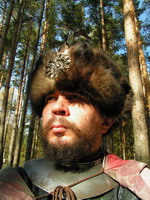| 21 января 2009 |
| 02:29 - Себе на заметку
|
Ссылки на годы происхождения некоторых танцев, нам известных в том числе - их выделю жирным
Forming in 1892 the British Association of Teachers of Dancing commenced running annual competitions to discover new sequence dances and as a consequence of this the first of the created or �choreographed� dances came into being. Several new quadrilles such as the Hussars (1894), Carnival (1895), The Gordons� Square (1898), Princess Ena Quadrille (1906) and the County Cotillion (1907) were also invented.
However quite significantly the Veleta Waltz, the first perceived choreographed sequence dance, was entered in 1899 but it didn�t win a place. The music publishers Francis, Day & Hunter, noted its potential and with the co-operation of the arranger Arthur Morris, it was re-vamped and introduced as a new dance in 1900. The Veleta was not really the first of the competition dances. One example is the Victoria Cross of 1898 by James Finnigan. According to F. Mainey (Old Time Dancers Handbook) this dance is exactly the same as the Military Two Step which Finnigan�s daughter brought out in 1904.
Nevertheless in popular opinion the Veleta is accepted as the dance that set the pattern for the popularity of many of the new �choreographed sequence dances�. Some of these included the Fylde Waltz 1902, Military Two Step 1904, the St Bernard Waltz (1904), Eva Three Step 1904, the Boston Two Step 1908, La Rinka 1908, Doris Waltz 1909, Latchford Schottische 1909, King�s Waltz 1913, the Maxina of 1917, Bradford (progressive) Barn Dance 1919 and the Royal Empress Tango 1922.
The Parma Waltz of 1920 doesn�t appear to have survived in England. But it certainly became popular in Australia along with the Pride of Erin(1911) by the 1930s. The date of origin of the Pride of Erin remains obscure in its native Britain, but the late Shirley Andrews had evidence to suggest it was 1924. Significantly all of these early dances in Britain were still described step by step with the five balletic feet positions on the toes. These new sequence dances were popular in the dance teachers� academies but were not sensations in the manner of great dances of the world when they were first introduced:- i.e. the Waltz, Polka, Mazurka, Quadrille, Lancers, Schottische and Varsoviana or the modern Foxtrot, Tango and Quickstep.
However the revival of Old Time dancing in the 1930s and subsequently in most decades thereafter established a sound footing for simple to follow sequence dances in which ordinary people could easily participate and enjoy. In the first instance many of the dances that had survived up until the First World War were re-introduced to the Ballroom under the Old Time umbrella. Generally the Country Dances didn�t make it although Victor Silvester and others like Michael Gwynne, Sydney Thompson and F. Mainey included the Dashing White Sergeant, Circassian Circle, Eighthsome Reel and Spanish Waltz in their Old Time Dance books of the 1940s and 50s. Mainey also gave a description of La Galopede stating it was within living memory. However the sets; Lancers, First Set, Caledonians, Waltz Cotillion and Alberts were all prominent along with the Polka Mazurka, Polka, Schottische, Barn Dance and Varsoviana. At the time of the First World War the newest of the sequence dances like the Eva Three Step tended to be eclipsed because Modern Ballroom Dancing had just taken off. The modern dances were the new time setters. The older dances of the earlier 20th century, although overshadowed, had established the pattern of the modern sequence dance even though their particular steps were still on the toes in the five balletic feet positions.
Оригинальная статья тут
http://home.vicnet.net.au/~bushdanz/articles_history.html
|
|
|
|
« Предыдущая запись |
Вернуться к записям |
Следующая запись »
|
|
| Комментарии |
| Arthur de Gorn |
01 февраля 2009 14:27
|

Приключенец
|
Dance Dating from:
Alberts 1882
Barn Dance 1860
Barn Dance Progressive 1919
Berlin Polka 1836
Boston Two Step 1908
The Doris Waltz 1908
La Rinka 1909
Caledonians 1830
Canadian Barn Dance 1919
Cheshire Rounds 1803
Circassian Circle 1844
Circle Waltz 1875
Colonials Quadrille Victorian
The County Cotillon 1907
Dashing White Sergeant Victorian
Doris Waltz 1908
Eva Three Step 1904
Evening Three Step 1904
Le Militaire 1905
The First Set 1815
Four Sisters Barn Dance 1915
French Cotillon 1882
Galop Quadrille Victorian
Galopade Quadrille 1882
Galopede Victorian
Gay Gordons Victorian
Grand March 1844
Gypsy Tap 19?
Kings Waltz 1913
Lancers 1817
Maxina 1917
La Militaire 1905
Military Two Step 1903
National Guard Quadrille Victorian
La Nationale 1910
Parma Waltz 1920
Parisien Quadrille 1875
Pride of Erin 1900
Prince Imperials 1875
Polka Mazurka 1875
Prince Imperial Quadrille Victorian
Princess Polka Victorian
Progressive Barn Dance 1919
Progressive Gay Gordons Victorian
Sir Roger De Coveley 1810
Spanish Waltz 1827
St Bernard’s Waltz 1934
Swing Waltz 1939
Tango Waltz 1932
Tangoette 1908
Varsoviana 1853 & 1885
Veleta 1900
Waltz 1815
Waltz Cotillon 1830
Waltz Country Dance 1827
Washington Post 1894
|
|
|
|
|
|
|
август |
| пн |
вт |
ср |
чт |
пт |
сб |
вс |
| | | | | 1 | 2 | 3 | | 4 | 5 | 6 | 7 | 8 | 9 | 10 | | 11 | 12 | 13 | 14 | 15 | 16 | 17 | | 18 | 19 | 20 | 21 | 22 | 23 | 24 | | 25 | 26 | 27 | 28 | 29 | 30 | 31 |
|